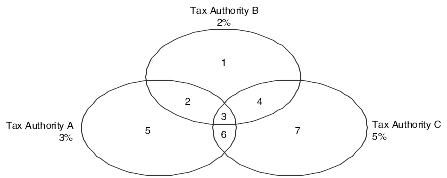Understanding Tax Rate Areas
To calculate and track the different taxes that you pay to suppliers or for customers, you must set up tax rate areas. Each tax area is a physical, geographic area, such as a state, province, or county. Different tax authorities assess a variety of taxes for each geographic area. Additionally, each authority within a tax area can have a different tax rate.
When you set up tax rate areas, you must specify effective dates. The system does not check for duplicate tax rate and area information, which means that you can set up different tax rates and effective date ranges for the same tax rate and area. The system checks for overlapping effective date ranges. When an overlap exists, the system issues an error.
The Tax Rates/Areas (P4008) program also provides features for special situations. For example, you can specify whether tax is calculated as tax-on-tax, whether a portion of the tax is nonrecoverable (available for input credits), and whether maximum unit cost is associated with a particular item.
This diagram illustrates how some tax areas could be organized:

The three circles represent three tax authorities. The seven numbered areas represent tax areas.
Notice that tax authority jurisdiction can overlap and that a tax area can be assessed taxes by one or more tax authorities. The tax rate for a tax authority does not vary from one tax area to another. Tax authority A assesses a 3 percent tax in tax areas 2, 3, 5, and 6.
For each tax area, however, the total tax burden can vary. It is the cumulative effect of multiple tax authorities for a single tax area that causes the tax burden to vary from one tax area to another. For example, the businesses located in tax area 5 must remit tax to only one tax authority (Tax Authority A for 3 percent). Businesses in tax area 2 remit taxes to two tax authorities (Tax Authorities A for 3 percent and B for 2 percent), and businesses in tax area 3 remit taxes to all three tax authorities.
You can run a report to review all of the tax areas that are set up.